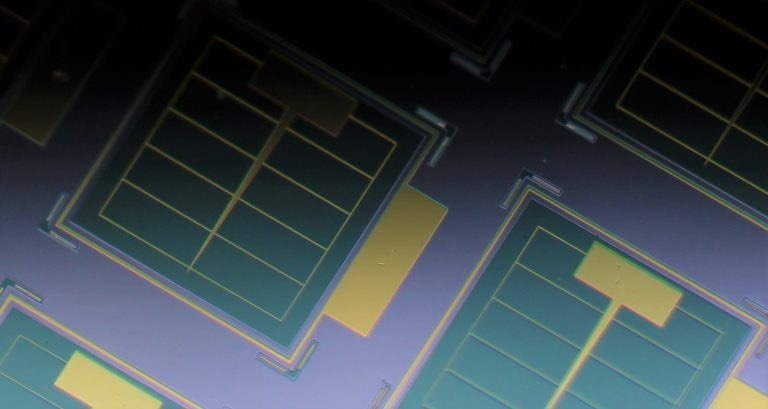Reviewed by Emily Henderson, B.Sc.Nov 9 2022
The majority of space satellites have been powered by photovoltaic cells that have the potential to convert sunlight into electricity. Vulnerability to a few kinds of radiation in orbit could harm the devices, thereby deteriorating their performance and restricting their lifetime.
 Photo of ultrathin on-chip solar cells. The cells are the green squares and include an ultrathin layer of light-absorbing GaAs, which is key to their radiation tolerance. The surface of each green square is only 120 nanometers, about one-thousandth the thickness of a human hair, above the surrounding gray area. The gold-colored grids are electrically conducting metal contacts. Image Credit: Armin Barthel
Photo of ultrathin on-chip solar cells. The cells are the green squares and include an ultrathin layer of light-absorbing GaAs, which is key to their radiation tolerance. The surface of each green square is only 120 nanometers, about one-thousandth the thickness of a human hair, above the surrounding gray area. The gold-colored grids are electrically conducting metal contacts. Image Credit: Armin Barthel
Researchers from the University of Cambridge suggested a radiation-tolerant photovoltaic cell design that traits an ultrathin layer of light-absorbing material.
The study has been reported in the Journal of Applied Physics by AIP Publishing.
When solar cells tend to absorb light, they convert its energy into electrons in the material that is negatively charged. Such charge carriers are knocked free and produce a flow of electricity throughout the photovoltaic.
Irradiation in space results in harm and reduces the efficiency by moving atoms in the solar cell material and decreasing the lifetime of the charge carriers. Making photovoltaics thinner must increase their longevity since the charge carriers have only a brief way at the time of their shortened lifetimes.
Since low Earth orbit turns out to be highly cluttered with satellites, it becomes progressively essential to utilize the middle Earth orbits, like the Molniya orbit that crosses via the center of Earth’s proton radiation belt. Hence, radiation-tolerant cell designs will be required for such higher orbits.
One more application for radiation-tolerant cells is known to be the study of other planets and moons. For instance, Europa, a moon of Jupiter, consists of one of the most serious radiation environments in the entire solar system. Therefore, landing a solar-powered spacecraft on Europa will need radiation-tolerant devices.
The investigators constructed two kinds of photovoltaic devices with the help of the semiconductor gallium arsenide. One was present on an on-chip design built by layering various substances in a stack. The other design consisted of a silver back mirror to improve light absorption.
To copy the effects of radiation in space, the devices were attacked with protons produced at the Dalton Cumbrian Nuclear Facility in the United Kingdom (U.K). The photovoltaic devices’ performance before and after irradiation was learned using a method called cathodoluminescence, which can estimate the amount of radiation damage.
The second set of tests utilizing a Compact Solar Simulator was performed to identify how well the devices transformed sunlight to power after being shelled with protons.
Our ultra-thin solar cell outperforms the previously studied, thicker devices for proton radiation above a certain threshold. The ultra-thin geometries offer favorable performance by two orders of magnitude relative to previous observations.
Armin Barthel, Study Lead Author, American Institute of Physics
The authors stated that the enhanced performance of such ultra-thin cells is due to the charge carriers having a longer life to travel between device terminals.
Compared to the thicker cells, almost 3.5 times less cover glass is required for the ultra-thin cells to provide the same amount of power after two decades of operation. This will convert into a lighter load and considerably decrease launch charges.
Journal Reference:
Barthel, A., et al. (2022) Radiation effects in ultra-thin GaAs solar cells. Journal of Applied Physics. doi.org/10.1063/5.0103381.